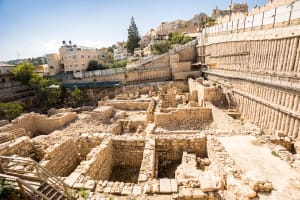Discovery now confirmed: A massive moat defended biblical Jerusalem from the north during Iron Age
For the past century and a half, archaeologists have struggled to pinpoint the route of Jerusalem's northern fortification

Excavations of the Givati Parking Lot in Jerusalem's City of David have uncovered a massive fortification system, solving a 150-year-old archaeological mystery. A formidable moat, carved from rock, created an impassable barrier between the City of David and the Temple Mount, including the area of Ophel. This moat formed the northern defensive boundary of the lower city during the Iron Age period. Researchers were initially puzzled regarding its purpose.
The discovery was already published in October of last year, however, archaeologists who interpreted the results weren't confident enough to conclusively confirm the dating hypothesis of the moat. Today, the results and the implications are stunning and the research will be presented at a conference in August.
Over the past century and a half, archaeologists have struggled to pinpoint the route of Jerusalem's northern fortification. Only now, during these significant excavations conducted by the Israel Antiquities Authority (IAA) and Tel Aviv University, has this fortification been revealed. The project is supported by the City of David Foundation.

The moat's creation was a monumental engineering feat, altering the natural landscape to display the might of biblical Jerusalem leaders. The precision and resources required for such a project highlight the city's strength and the technical abilities of its engineers at that time.
Prof. Yuval Gadot from Tel Aviv University's Department of Archaeology and Ancient Near Eastern Cultures and IAA's Dr. Yiftah Shalev lead the excavation. They note that while the exact date of the moat's construction remains uncertain, evidence suggests it was used during Jerusalem's tenure as the capital of the Kingdom of Judah during the Iron Age period (also known as the Israelite period), while King Josiah ruled over Jerusalem less than 3,000 years ago. This moat may have served as a boundary between the southern residential district and the northern acropolis, home to the palaces and the temple.
Further insights emerged when the team revisited excavation reports from the 1960s by British archaeologist Kathleen Kenyon. Her observations, which previously seemed to erroneously indicate a natural valley, were now recognized as part of this extensive artificial moat. This newly identified section stretches at least 70 meters (230 ft) from west to east, reinforcing the moat's significance.
The researchers hypothesize that if the moat dates back to the Middle Bronze Age (about 3,800 years ago), it was likely designed to protect Jerusalem from the north, which would have been its only vulnerable point. Regardless of its original date, the moat was undoubtedly being used during the First Temple period, creating a clear division between the city's residential and upper areas.

Jerusalem's ancient landscape, characterized by its steep ridges and separated hills and valleys, necessitated significant royal construction efforts to modify its topography. Such endeavors are documented in biblical texts, including the Book of Kings (11:27), where King Solomon fortified the "Millo" to secure the City of David.
Although the archaeologists involved in the excavations cannot precisely date the beginning of the moat, they are certain it existed before the kings of Judah in the 9th and 8th centuries B.C. While open to the possibility that the moat dates back to the Canaanite period of Jerusalem during the Bronze Age, the archaeologists appear hesitant to openly assert that it could have been dug during the era of a unified kingdom of Israel under Kings David and Solomon during the 10th century B.C.
Unlike archaeologists such as Eilat Mazar and Yosef Garfinkel, who are more commonly associated with the "Maximalist" school, Gadot and other archaeologists from Tel Aviv University who discovered the moat may still find it challenging to openly accept the biblical narrative as historical. This particularly pertains to the significance of the united monarchy and the existence of iconic kings like David and Solomon as described in the Bible.
Eli Escusido, the director of IAA, emphasized the extraordinary significance of the ongoing discoveries within the City of David, including their profound connection to biblical narratives. Standing amid the vast excavation site, one cannot help but marvel at the ancient Israelites' ability to reshape their environment so dramatically.
The excavation results, to be showcased at the upcoming "Jerusalem Studies Experience" Conference in early August, promise to shed further light on Jerusalem's storied past.
Since 2007, the ongoing Givati Parking Lot excavation has revealed significant archaeological finds spanning from the First Temple period to the Byzantine era, including large residential buildings, ivory decorations, seal impressions, and a cache of gold coins. These discoveries provide valuable insights into Jerusalem's historical and cultural development across various periods.

The All Israel News Staff is a team of journalists in Israel.
You might also like to read this:














